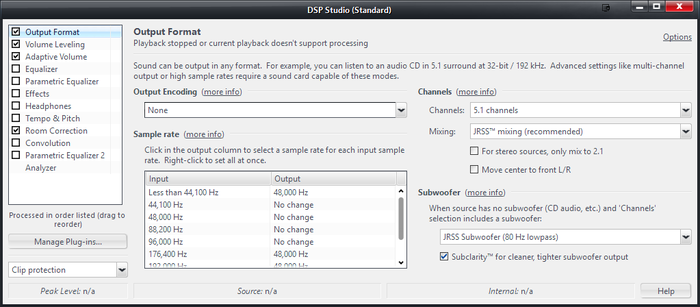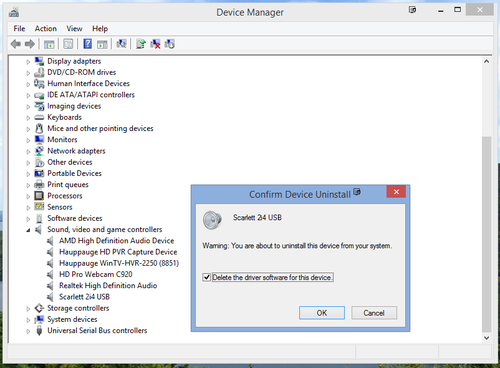Audio Troubleshooting Guide
- further information: Troubleshooting Guide
A frequent cause of trouble is a misconfigured, or misbehaving, audio device. If you've messed with a bunch of settings in there, or you are using a more esoteric hardware setup, then you might just have to tweak something.
Troubleshooting Steps
- Work through the Audio Setup Guide
- Check on a few basics.
- Disable any DSP items you've enabled, to see if one of them is causing the issue.
- Check your Audio Device. If you can, try different audio outputs on the computer, to see if one in particular is having issues while others work.
- Make sure the amplifier or device at the other end (speakers, receiver, DAC, etc) is functioning properly, set to the right inputs, etc.
- Try another device using the same input on your receiver or speakers to ensure it isn't a problem with your amplification system.
Basics
The first thing to do is check through some basic issues. Even if these don't resolve the issue, they will gather additional basic details about the issue which will be useful when asking for help.
No Sound:
- Is there an audio device installed on the computer? Check Device Manager to ensure there's an audio device and that it is enabled and working.
- Is sound muted? Double click on the speaker icon in the lower right corner of the Windows desktop, and under the Volume button in Media Center.
- Work through the Audio Setup guide.
- If all else fails, try switching to Direct Sound Audio Output Mode (Windows only).
Poor Audio Quality, Skipping, File Ends Prematurely, or Sound Output is Garbled:
- Reboot. Your audio driver might be in an unhappy state, and rebooting will probably bring it back. If this works, but recurs, you may have a broken audio device driver (see below).
- Try playing the track with an alternative media player to make sure the file itself isn't corrupt. If you don't have a good option, VLC is cross platform and will play almost anything you throw at it.
- Disable "advanced" Audio Options such as Play files from memory, Bitstreaming, and custom Live Latency settings.
- Your source disk could be misbehaving. Try copying some files over to your system disk (or another disk, if already on the system disk) and play them from there to see if the problem goes away. For more help with disks, refer to the Troubleshooting Disks article.
- Trouble with Pops and Clicks?
Is the Issue File Specific or File Type Specific?
- See if the problem occurs with files of various types. If you're having trouble with FLAC or AIFF playback, try some MP3s. If audio in a video file doesn't work, try some simple audio files.
- Try to narrow down if the issue occurs with only specific files (regardless of type) or if it applies to all files of a particular type.
Is There An Error Message?
- When Media Center fails to play a file, it typically provides an error message. This message should provide additional details about the problem. When asking for help, please try to include the error message text verbatim so that we understand the issue fully.
Does Media Center Crash or Hang?
- Crashing or Hanging when you play a particular file back is often due to a corrupt source file. Be sure to check the file(s) with an alternative player.
- If the files work properly in another player, but make MC crash or hang, please refer to the Troubleshooting Guide and follow the instructions provided.
- When posting about the issue, please include the Logging Report package as described in the Troubleshooting Guide. It is also often helpful to provide the source file that causes the issue. You can use a service like Dropbox or WikiSend to create a public link to the file and post this link in the thread.
Do You Get a Format Error on Playback?
- This almost always often caused by an incorrect in the Output Format DSP, or by an attempt to play back audio at a sample rate or channel count that your hardware does not support.
- If you are using WASAPI Output Mode, then check to ensure that Exclusive Mode is enabled.
- If the error occurs when playing multichannel or mono audio, be sure that JRSS is enabled in the Output Format DSP so that MC can mix to the proper number of output channels.
DSP Troubleshooting
If you determine the cause is caused by the DSP:
- Re-enable all of the DSP items you want to use.
- Disable them one at a time and try to recreate the issue.
Some DSP options require substantial computing horsepower, such as the Convolution Filter. You may find that your computer simply isn't powerful enough to accomplish what you're trying to do (at least with the types of sources you are using). However, it could be a simple misconfiguration. In particular, Output Encoding and Sample Rate settings under the Output Format DSP are a common cause of trouble. In most cases, the best quality will be achieved by leaving these at their defaults.
Checking for Misbehaving Audio Devices
If none of the above helps, or if you determine that the problem is related to a particular audio device, a good next step is to disable or physically disconnect any audio devices that might be misbehaving.
You may want to consider this particularly if you are getting crashes immediately when launching MC, or immediately upon playback of an audio file. Sometimes doing this through the Device Manager in Windows works, and sometimes it doesn't, and you must physically remove the device from the PC. With external devices, like USB DACs, unplug it from the PC and try the same thing using the PC's built-in audio.
In some cases, simply removing the device physically, and then booting Windows without the device installed will allow Windows to correct the driver issue. In many other cases, you may want to fully uninstall the device and all of its drivers and then start over from scratch.
To Uninstall the device driver from Windows fully:
- Go to the Uninstall Programs control panel, and remove all entries related to your audio device.
- Do not restart when prompted.
- Click Start and type: Device Manager
- Hit enter to open the Device Manager.
- Find the audio device in question under Sound, video and game controllers (be sure not to choose it via the Audio Inputs and Outputs part of Device Manager).
- Right click on the device and choose Uninstall.
- In the dialog that appears, check the Delete the driver software for this device option.
- Click OK to confirm.
- Shut down the PC and physically remove the offending device (if it is removable).
- Boot back up "cleanly" once.
- Obtain the latest version of the drivers for your device from the hardware manufacturer.
- Shut back down again, and then you can try reinstalling your audio device.
More
- Our Wiki topic, "Weird and Wonderful", has a long list of problems caused by other hardware and software.

